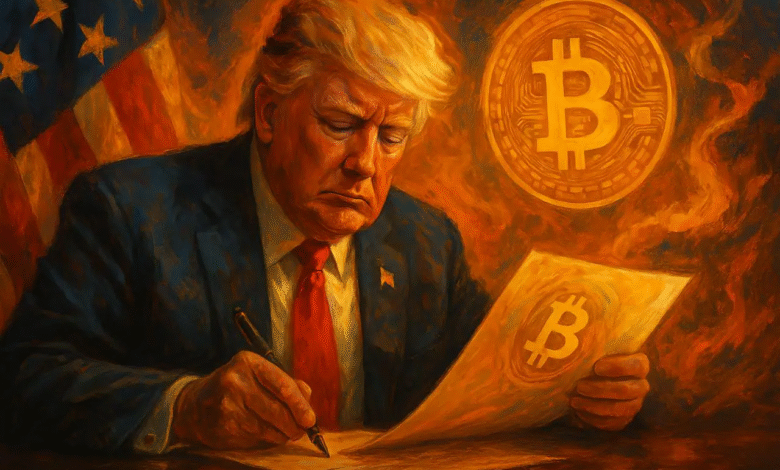Crypto Executive Orders That Could Transform Markets

In a bold move, crypto executive orders have been signed by President Donald Trump, marking a pivotal shift in the landscape of digital finance in the United States. These orders are set to enhance banking freedoms and promote access to cryptocurrency in retirement accounts, a decision that particularly resonates with individuals seeking financial independence through asset diversification. By enabling retirement savings to include digital assets, millions of Americans can potentially enjoy robust diversification strategies that are crucial to long-term financial health. The implications of Trump’s crypto initiatives extend beyond personal finance, potentially invigorating the digital asset market and fostering a new era of innovation in banking practices. As discussions around cryptocurrency retirements gain traction, these executive orders may pave the way for increased participation and investment in the rapidly evolving landscape of cryptocurrencies.
The latest directives from the Trump administration serve as crucial legislative actions that could redefine digital finance. By implementing groundbreaking policies that promote access to cryptocurrencies within retirement portfolios, these executive measures aim to uphold banking rights and challenge previous restrictions. The initiative highlights a progressive approach towards including alternative assets, like digital currencies, in the financial planning of everyday Americans. Discussions around enhancing banking freedoms and the ability to navigate the financial landscape free from ideological biases are becoming more relevant than ever. As the dialogue on fiscal autonomy and investment diversification intensifies, these executive orders reflect a pivotal moment for the integration of digital assets into mainstream financial strategies.
Trump’s Executive Orders and Their Impact on Banking Freedoms
In a landmark move, President Trump’s recent executive orders aim to dismantle barriers previously set against certain political and ideological groups in the banking sector. By ensuring that individuals cannot be discriminated against based on their political affiliations or beliefs, these measures are poised to create an environment that fosters banking freedoms. This initiative not only promotes fairness but also reinstates financial rights that had been under threat, thereby empowering all Americans to gain equal access to banking services without fear of repression due to their personal ideologies.
The implications of such orders are profound, especially within the context of cryptocurrency adoption. By safeguarding banking freedoms, it is expected that many individuals will feel more secure in engaging with digital asset investments. This bolstered confidence could lead to an influx of new investors in the cryptocurrency space, which could potentially rejuvenate crypto markets and drive innovation. Furthermore, this renewed trust is essential for a safe and sustainable crypto ecosystem as it opens the doors for diverse investment strategies without political or ideological bias.
Unlocking the Potential of Cryptocurrency in Retirement Accounts
The second executive order, focusing on retirement assets, marks a significant shift in how American workers can diversify their portfolios. With this new directive, millions will have the ability to incorporate cryptocurrencies into their retirement accounts, reflecting a modern approach to financial planning. As more individuals seek financial independence and smarter investment strategies, the inclusion of digital assets may allow for greater returns and enhanced portfolio diversification. This could revolutionize how retirement savings are conceived, especially as younger generations are increasingly inclined toward innovative investment vehicles like crypto.
Moreover, the move to include cryptocurrencies in 401(k) plans is not just a win for individual investors but also reflects a broader acceptance of digital assets within traditional financial frameworks. This decision advocates for a future where cryptocurrencies are considered legitimate forms of investment alongside stocks and bonds, encouraging mainstream adoption. As workers recognize the potential growth of digital assets, the landscape of retirement planning is bound to evolve, creating opportunities for greater financial security during retirement.
The Role of Digital Assets in Achieving Financial Independence
As the financial landscape continues to evolve, the concept of financial independence is taking on new meaning for many individuals. With the launch of policies enabling broader access to cryptocurrencies, more Americans are considering digital assets as a vital component of their investment strategies. Emphasizing diversification, cryptocurrencies allow individuals to protect their wealth against potential market instability while also tapping into the high growth potential associated with digital currencies. Thus, for many, embracing cryptocurrencies is seen as an essential step toward establishing financial independence.
The allure of cryptocurrency lies especially in its ability to provide alternative investment options that can yield substantial returns compared to traditional assets. By including these digital assets in retirement accounts, individuals are empowered to take charge of their financial futures, mixing their portfolios with unique assets that can outpace conventional investments. Therefore, this strategic inclusion not only broadens investment options but also fortifies the pathway toward achieving greater financial independence.
The Future of Banking and Cryptocurrency Under Trump’s Orders
President Trump’s executive orders signal a progressive shift towards more inclusive financial policies that cater to a varied demographic of investors. By prohibiting financial institutions from discriminating based on political beliefs, the banking sector stands to experience a revitalization where diverse financial ideologies can coexist. This evolution is crucial for the re-establishment of trust and transparency in banking, allowing more innovative approaches to emerge within the financial sector, especially concerning cryptocurrency.
As digital currencies continue to gain traction, the influence of Trump’s directives could be pivotal in shaping the relationship between traditional banking and cryptocurrencies. Establishing an environment where digital assets are integrated into mainstream financial planning reflects a future where banking freedoms flourish alongside innovative investment strategies. As this landscape evolves, we may witness a synergistic relationship between banking practices and the growing digital economy.
Incentives for Crypto Investment Through New Retirement Strategies
With the new executive orders in effect, there is a clear incentive for individuals to incorporate cryptocurrencies into their retirement strategies. The ability to now allocate portions of 401(k) plans to digital assets could entice millions to invest in cryptocurrencies who previously viewed them as high-risk. This strategic shift not only promotes a diversified investment approach but also ensures that retirement savings can potentially reap the benefits of the booming digital asset market.
As more workers embrace this opportunity to invest in cryptocurrencies, we could see a significant increase in the overall acceptance and smoothing of market volatility associated with these assets. Moreover, the recognition of cryptocurrencies as a legitimate retirement investment may lead to a more stable long-term investment landscape as institutional support builds. With this change, we are looking at a future where cryptocurrencies are not merely speculative assets but integral components of financial planning.
The Significance of Cryptocurrency Accessibility in Retirement Planning
The ability to include cryptocurrencies in retirement accounts presents a significant paradigm shift for how future generations approach financial planning. As digital assets become increasingly mainstream, their inclusion in 401(k) plans will not only attract more young investors but also align traditional retirement strategies with evolving market trends. This accessibility promotes a broader understanding of financial diversification, allowing individuals to experiment with a mix of assets that match their risk tolerance and financial goals.
Furthermore, as the market for cryptocurrencies expands, having the opportunity to invest in these digital assets legally and straightforwardly through retirement accounts will enable a seismic shift in how wealth accumulation strategies are formulated. This change could potentially redefine success in retirement planning, making it more inclusive and performance-oriented. Individuals will no longer solely rely on traditional retirement vehicles but rather craft personalized, diversified portfolios that meet contemporary investment needs.
Addressing Concerns of Discrimination in Financial Services
One key aspect of President Trump’s executive orders is the commitment to addressing discrimination within financial services. By establishing rules that protect individuals’ rights to banking based on their lawful activities and beliefs, this initiative aims to build a more equitable financial system. The orders serve to reassure American citizens that their banking options will not be influenced by ideology, thus instilling a sense of security and confidence in their financial transactions.
This commitment to fairness has implications that extend beyond personal comfort; it also promotes trust between consumers and financial institutions. As individuals feel more secure knowing that their rights won’t be compromised due to their beliefs, engagement with banking services—particularly those involving cryptocurrency—could increase. Such openness can encourage innovation and the growth of new financial products, including digital currencies, thereby enhancing overall market growth.
Cryptocurrency as a Tool for Investment Diversification
The concept of diversification has become increasingly critical in the investment world. By allowing cryptocurrencies within retirement accounts, President Trump’s orders present a golden opportunity for individuals to enhance their investment strategies. This diversification with digital assets serves not only to mitigate risk but also to capitalize on the higher returns that cryptocurrencies can offer compared to traditional investment avenues. As more people recognize the potential benefits of adding cryptocurrencies to their portfolios, the shift towards digital assets could accelerate.
Investors are often advised to spread their risks across varied asset classes, and cryptocurrencies now represent a vital option in achieving that goal. Given their unique characteristics and market behaviors, digital assets can act as a hedge against inflation and economic downturns, reinforcing the importance of strategic asset allocation in a comprehensive investment plan. As Trump’s policies pave the way for increased crypto adoption, we may see a transformative effect on how individuals approach financial diversification and overall wealth management.
Implications for Future Financial Policies Surrounding Cryptocurrency
The successful implementation of President Trump’s executive orders could inspire further financial policy reforms aimed at integrating cryptocurrencies into mainstream finance. By taking steps to protect banking freedoms and enhancing access to digital assets, these measures could set a precedent that encourages legislative bodies to explore additional avenues for simplifying cryptocurrency regulations. This could include defining clearer frameworks for taxation, transaction processes, and investment practices related to digital assets.
Looking ahead, policymakers may also consider how to enhance consumer protection in the cryptocurrency space. As digital assets gain traction, it becomes increasingly important to educate and shield investors from potential pitfalls. Trump’s executive orders may act as a catalyst for comprehensive regulation that balances innovation in the crypto sector with necessary oversight to protect consumers, creating a more stable environment for investors willing to partake in the growing influence of cryptocurrencies.
Frequently Asked Questions
What are the primary implications of Trump’s crypto executive orders for cryptocurrency retirement accounts?
Trump’s executive orders aim to broaden access to cryptocurrency retirement accounts by allowing alternative assets, including cryptocurrencies, in 401(k) plans. This change potentially enables over 90 million American workers to diversify their retirement investments with digital assets, enhancing their financial independence and improving long-term returns.
How do Trump’s executive orders protect banking freedoms related to cryptocurrency transactions?
The executive orders signed by Trump are designed to safeguard banking freedoms by preventing discrimination based on political beliefs, religious affiliations, or lawful business practices. This ensures that individuals engaging in cryptocurrency transactions cannot be unfairly targeted by banks, fostering a more inclusive financial environment.
What does the executive order ‘Democratizing Access to Alternative Assets for 401(k) Investors’ mean for digital assets diversification?
The order facilitates the inclusion of cryptocurrencies and other alternative assets in retirement plans, promoting digital assets diversification for American workers. This change is expected to provide greater investment opportunities and enhance overall financial independence for those in the retirement savings system.
What role does the ‘Guaranteeing Fair Banking for All Americans’ executive order play in the crypto market?
This executive order aims to eliminate discriminatory practices in banking, directly impacting the crypto market by ensuring that individuals engaged in cryptocurrency cannot be denied banking services based on their beliefs or activities. This creates a more favorable environment for crypto transactions and investments.
How might Trump’s executive orders affect financial independence for everyday Americans?
By allowing cryptocurrency investments in retirement accounts and protecting banking freedoms, Trump’s executive orders enhance financial independence for everyday Americans. They provide access to diverse investment options and ensure that financial institutions cannot impose restrictions based on ideological factors.
How does the inclusion of cryptocurrencies in retirement accounts align with current trends in financial markets?
The inclusion of cryptocurrencies in retirement accounts reflects a growing trend towards digital assets diversification and aligns with a broader movement towards alternative investments in financial markets. This aligns with an increasing recognition of cryptocurrency’s legitimacy as a viable investment option.
What are the potential impacts of Trump’s executive orders on the legitimacy of digital assets in mainstream finance?
Trump’s executive orders may significantly bolster the legitimacy of digital assets in mainstream finance by promoting policies that increase their accessibility and protection against discrimination. As more Americans include cryptocurrencies in their retirement planning, the perception and acceptance of these assets in the financial sector could improve.
What steps are being taken to ensure financial inclusion through these crypto executive orders?
The executive orders prioritize financial inclusion by expanding access to alternative investments, including cryptocurrencies, in retirement accounts and reinforcing protections against discriminatory banking practices. This approach is designed to foster an equitable marketplace for all individuals, regardless of their political or ideological background.
| Key Point | Details |
|---|---|
| Executive Orders Overview | President Trump signed two executive orders aimed at transforming U.S. finance, enhancing banking freedoms and allowing cryptocurrency access in retirement accounts. |
| First Executive Order: Fair Banking | This order prevents discrimination in banking services based on political or religious beliefs, ensuring all Americans have access to banking irrespective of their ideologies. |
| Second Executive Order: Retirement Access | Allows inclusion of cryptocurrencies in federal retirement plans, enabling over 90 million American workers to diversify their retirement investments. |
| Implications for Crypto | These measures are seen as crucial for market innovation and financial inclusion, enhancing the legitimacy of digital assets in retirement planning. |
| Support and Opposition | Supporters praise the orders for promoting financial freedom, while critics remain skeptical about the long-term impacts on banking and retirement sectors. |
Summary
Crypto executive orders signed by President Trump represent a significant shift in the U.S. financial landscape. By promoting fair banking practices and enhancing access to cryptocurrencies in retirement accounts, these orders aim to empower millions of Americans in their financial decisions. The potential for improved investment diversification and stronger protections against discriminatory banking practices underscores the importance of these directives in shaping the future of cryptocurrency in the United States.




